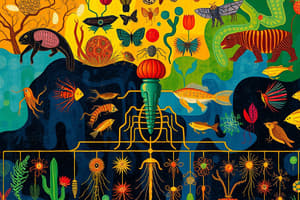Podcast
Questions and Answers
Which of the following is NOT a primary threat to biodiversity?
Which of the following is NOT a primary threat to biodiversity?
- Habitat loss
- Climate change
- Invasive species
- Increased genetic diversity (correct)
In the Linnaean taxonomic system, which of the following represents the correct order from the broadest to most specific classification?
In the Linnaean taxonomic system, which of the following represents the correct order from the broadest to most specific classification?
- Domain, Kingdom, Phylum, Class (correct)
- Species, Genus, Family, Class
- Genus, Family, Order, Kingdom
- Family, Order, Class, Phylum
Which characteristic is unique to eukaryotic cells, but absent in prokaryotic cells?
Which characteristic is unique to eukaryotic cells, but absent in prokaryotic cells?
- Cell membrane
- Membrane-bound organelles (correct)
- DNA
- Ribosomes
What is the main difference between the lytic and lysogenic cycles of a virus?
What is the main difference between the lytic and lysogenic cycles of a virus?
Which of the following kingdoms contains organisms that are primarily decomposers and are mostly multicellular?
Which of the following kingdoms contains organisms that are primarily decomposers and are mostly multicellular?
Which of the following best explains the cause of antibiotic resistance in bacteria?
Which of the following best explains the cause of antibiotic resistance in bacteria?
What is a key function for phages in genetic engineering?
What is a key function for phages in genetic engineering?
In DNA structure, which of the following describes complementary base pairing?
In DNA structure, which of the following describes complementary base pairing?
What is the main outcome of meiosis?
What is the main outcome of meiosis?
Which term describes a condition where an individual has three copies of a particular chromosome?
Which term describes a condition where an individual has three copies of a particular chromosome?
In a monohybrid cross, what is being analyzed?
In a monohybrid cross, what is being analyzed?
Which of these is an example of codominance?
Which of these is an example of codominance?
What is the primary function of the left ventricle?
What is the primary function of the left ventricle?
Which of the following best describes tidal volume?
Which of the following best describes tidal volume?
Which enzyme primarily breaks down fats?
Which enzyme primarily breaks down fats?
What is a key distinction between homologous and analogous structures?
What is a key distinction between homologous and analogous structures?
Which of the following best describes the bottleneck effect as it relates to evolution?
Which of the following best describes the bottleneck effect as it relates to evolution?
What type of evolutionary pattern is exemplified by the diversification of Darwin's finches?
What type of evolutionary pattern is exemplified by the diversification of Darwin's finches?
Flashcards
Biodiversity
Biodiversity
The variety of life on Earth, encompassing all living organisms and their ecosystems.
Classification
Classification
The process of grouping organisms based on shared characteristics.
Binomial Nomenclature
Binomial Nomenclature
A two-part scientific name for an organism, consisting of the genus and species names.
Eukaryotic Cells
Eukaryotic Cells
Signup and view all the flashcards
Prokaryotic Cells
Prokaryotic Cells
Signup and view all the flashcards
Endosymbiosis Theory
Endosymbiosis Theory
Signup and view all the flashcards
Viruses
Viruses
Signup and view all the flashcards
Antibiotic Resistance
Antibiotic Resistance
Signup and view all the flashcards
What is a karyotype?
What is a karyotype?
Signup and view all the flashcards
What is nondisjunction?
What is nondisjunction?
Signup and view all the flashcards
What is trisomy?
What is trisomy?
Signup and view all the flashcards
What is monosomy?
What is monosomy?
Signup and view all the flashcards
What is heredity?
What is heredity?
Signup and view all the flashcards
What is Mendel's Law of Segregation?
What is Mendel's Law of Segregation?
Signup and view all the flashcards
What is Mendel's Law of Independent Assortment?
What is Mendel's Law of Independent Assortment?
Signup and view all the flashcards
What do red blood cells do?
What do red blood cells do?
Signup and view all the flashcards
What do white blood cells do?
What do white blood cells do?
Signup and view all the flashcards
What do platelets do?
What do platelets do?
Signup and view all the flashcards
Study Notes
Diversity of Living Things
- Importance of Biodiversity: Essential for ecosystem stability, resilience, and human survival. Provides vital ecosystem services like food, clean water, medicine, and pollination.
- Threats to Biodiversity: Habitat loss, pollution, climate change, invasive species, and overexploitation are major threats.
- Classification System: Organisms are classified using the Linnaean system (DKPCOFGS): Domain, Kingdom, Phylum, Class, Order, Family, Genus, Species.
- Binomial Nomenclature: Two-part naming system (Genus species) – e.g., Homo sapiens.
- Dichotomous Keys: Tools used to identify organisms based on their characteristics.
- Domains and Kingdoms:
- Three Domains: Bacteria, Archaea, Eukarya.
- Six Kingdoms: Bacteria, Archaea, Protista, Fungi, Plantae, Animalia.
- Cladograms: Diagrams showing evolutionary relationships based on shared traits.
- Prokaryotic vs Eukaryotic Cells:
- Eukaryotic cells have membrane-bound organelles, including a nucleus.
- Prokaryotic cells lack membrane-bound organelles and have DNA in a nucleoid region.
- Endosymbiotic Theory: Eukaryotic cells evolved from prokaryotic cells engulfing other cells (e.g., mitochondria, chloroplasts).
- Viruses: Non-living entities composed of a protein coat (capsid) and genetic material (RNA/DNA).
- Viral Life Cycles:
- Lytic Cycle: Virus replicates and causes cell lysis.
- Lysogenic Cycle: Viral DNA integrates into host's genome, replicates passively, potentially entering a lytic cycle later.
- Kingdom Overviews:
- Bacteria: Prokaryotic, unicellular organisms that reproduce by binary fission.
- Archaea: Extremophile prokaryotes with unique biochemical features.
- Protists: Eukaryotic, unicellular or multicellular organisms with diverse nutritional strategies (e.g., algae, amoebas).
- Fungi: Eukaryotic, mostly multicellular (except yeasts), heterotrophic decomposers.
- Animals: Multicellular, eukaryotic, heterotrophic organisms with complex organ systems.
- Antibiotic Resistance: Overuse/misuse of antibiotics leads to the evolution of resistant bacteria.
- Biotechnology and Phages: Phages (bacterial viruses) are used in genetic engineering to deliver genetic material.
Genetic Processes
- DNA Structure: DNA consists of nucleotides (phosphate group, sugar, nitrogenous base). Complementary base pairing: A with T, G with C.
- Chromosomes:
- Haploid: One set of chromosomes (gametes).
- Diploid: Two sets of chromosomes (somatic cells).
- Autosomes: Non-sex chromosomes.
- Sex Chromosomes: Determine sex (XX or XY).
- Cell Division:
- Cell Cycle: Interphase (growth, DNA replication) and Mitotic phase (mitosis or meiosis).
- Mitosis: Cell division for growth/repair, producing two identical diploid cells.
- Meiosis: Cell division for sexual reproduction, producing four non-identical haploid cells.
- Karyotypes: Visual representations of an organism's chromosomes, used to detect abnormalities.
- Abnormal Meiosis (Nondisjunction):
- Trisomy: Extra chromosome (e.g., Down syndrome).
- Monosomy: Missing chromosome (e.g., Turner syndrome).
- Heredity:
- Mendel's Laws:
- Segregation: Alleles separate during gamete formation.
- Independent Assortment: Genes for different traits are inherited independently.
- Types of Inheritance:
- Complete Dominance: One allele masks the other.
- Co-dominance: Both alleles are expressed (e.g., AB blood type).
- Incomplete Dominance: Blending of traits (e.g., red + white = pink).
- Sex-linked Inheritance: Genes located on sex chromosomes.
- Autosomal Inheritance: Genes located on autosomes.
- Multi-trait Inheritance: Inheritance patterns involving multiple alleles (e.g., blood types).
- Genetic Engineering: Techniques to modify DNA (e.g. CRISPR).
Animals: Structure and Function
- Circulatory System:
- Blood Components: Red blood cells (oxygen transport), white blood cells (immune function), platelets (clotting), plasma (transport).
- Heart Structures: Atria (receive blood), ventricles (pump blood), valves (prevent backflow).
- Blood Pathway: Right atrium → right ventricle → lungs → left atrium → left ventricle → body.
- Cardiac Output: Volume of blood pumped per minute.
- Heart Sounds and Blood Pressure: Systolic (contracting) and diastolic (relaxing) pressures.
- Respiratory System:
- Structures: Nasal cavity, trachea, bronchi, alveoli (gas exchange).
- Breathing Mechanisms: Inhalation (diaphragm contracts), exhalation (diaphragm relaxes).
- Lung Capacity and Spirometer: Measures volumes (Tidal Volume, Vital Capacity, Residual Volume).
- Disorders: Asthma, COPD, lung cancer.
- Digestive System:
- Organs: Mouth, esophagus, stomach, small intestine, large intestine, liver, pancreas, gallbladder.
- Digestion: Mechanical (chewing) and Chemical (enzymes).
- Enzymes: Amylase (carbs), protease (proteins), lipase (fats).
- Disorders: Ulcers, acid reflux, diarrhea, constipation.
Evolution
- Darwin's Observations: Biogeography (species distribution), fossils (historical life forms), bird collections.
- Evidence for Evolution:
- Homologous/Analogous Structures: Homologous (similar structures, common ancestor); Analogous (different structures, similar function).
- Embryonic Evidence: Similar developmental patterns.
- Vestigial Features: Traits that have lost their original function.
- Fossil Record and DNA: Show evolutionary relationships and trends.
- Natural Selection: Differential survival and reproduction of organisms based on advantageous traits.
- Types of Selection:
- Directional: Favoring one extreme phenotype.
- Stabilizing: Favoring the average phenotype.
- Disruptive: Favoring both extreme phenotypes.
- Sexual Selection: Traits increasing reproductive success.
- Artificial and Sexual Selection: Human-driven vs. mate choice.
- Genetic Drift:
- Bottleneck Effect: Drastic reduction in population size due to environmental disruption.
- Founder Effect: Small group establishing a new population, leading to restricted genetic diversity.
- Speciation: Formation of new species, involving reproductive isolating mechanisms.
- Reproductive isolating mechanisms: Pre-zygotic (before fertilization) and Post-zygotic (after fertilization)
- Patterns of Evolution: Adaptive radiation (rapid diversification), divergent evolution (species diverge), convergent evolution (unrelated species develop similar traits), coevolution (species evolve together).
Studying That Suits You
Use AI to generate personalized quizzes and flashcards to suit your learning preferences.




